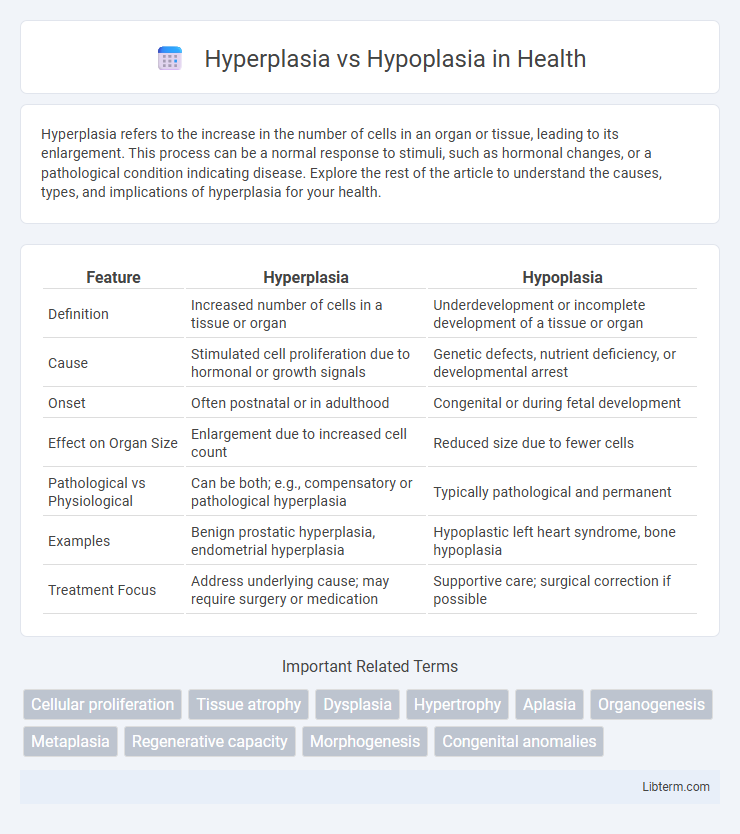Hyperplasia refers to the increase in the number of cells in an organ or tissue, leading to its enlargement. This process can be a normal response to stimuli, such as hormonal changes, or a pathological condition indicating disease. Explore the rest of the article to understand the causes, types, and implications of hyperplasia for your health.
Table of Comparison
| Feature | Hyperplasia | Hypoplasia |
|---|---|---|
| Definition | Increased number of cells in a tissue or organ | Underdevelopment or incomplete development of a tissue or organ |
| Cause | Stimulated cell proliferation due to hormonal or growth signals | Genetic defects, nutrient deficiency, or developmental arrest |
| Onset | Often postnatal or in adulthood | Congenital or during fetal development |
| Effect on Organ Size | Enlargement due to increased cell count | Reduced size due to fewer cells |
| Pathological vs Physiological | Can be both; e.g., compensatory or pathological hyperplasia | Typically pathological and permanent |
| Examples | Benign prostatic hyperplasia, endometrial hyperplasia | Hypoplastic left heart syndrome, bone hypoplasia |
| Treatment Focus | Address underlying cause; may require surgery or medication | Supportive care; surgical correction if possible |
Introduction to Hyperplasia and Hypoplasia
Hyperplasia refers to the increase in the number of cells within a tissue or organ, resulting in its enlargement due to enhanced cellular proliferation. Hypoplasia, in contrast, is characterized by the underdevelopment or incomplete formation of a tissue or organ caused by a reduced cell count during embryonic growth. Both conditions are critical in understanding developmental abnormalities and pathological changes in various medical disciplines.
Definitions: Hyperplasia vs. Hypoplasia
Hyperplasia is defined as the increase in the number of cells in a tissue or organ, leading to its enlargement, often in response to a stimulus. Hypoplasia refers to the underdevelopment or incomplete development of an organ or tissue, characterized by a reduced number of cells. These conditions represent opposite pathological processes affecting tissue growth and development.
Key Differences Between Hyperplasia and Hypoplasia
Hyperplasia refers to the increase in the number of cells within a tissue or organ, leading to its enlargement, while hypoplasia indicates underdevelopment or incomplete formation of a tissue or organ due to a reduced number of cells. Hyperplasia is typically a response to a stimulus, such as hormonal signals or injury, whereas hypoplasia is often congenital, resulting from genetic defects or developmental disturbances. The key differences lie in the cellular mechanism--hyperplasia involves proliferation of existing cells, and hypoplasia involves insufficient cell production during development.
Causes of Hyperplasia
Hyperplasia is caused by increased cell proliferation due to hormonal stimulation, chronic irritation, or compensatory mechanisms following tissue loss. Common examples include endometrial hyperplasia driven by excess estrogen and benign prostatic hyperplasia linked to androgen effects. Unlike hypoplasia, which results from incomplete tissue development due to genetic or environmental factors, hyperplasia reflects an adaptive increase in cell number to meet physiological demands or pathological stimuli.
Causes of Hypoplasia
Hypoplasia is caused by factors such as genetic mutations, intrauterine infections, nutritional deficiencies, and exposure to teratogens, leading to incomplete or underdeveloped organs or tissues. In contrast, hyperplasia results from increased cell proliferation due to stimuli like hormonal imbalances or chronic injury but involves normal tissue development. Understanding the etiology of hypoplasia is crucial for diagnosis and management of congenital anomalies and growth disorders.
Clinical Manifestations: Hyperplasia
Hyperplasia is characterized by an abnormal increase in the number of cells within a tissue or organ, often leading to enlargement and functional changes. Clinical manifestations of hyperplasia vary depending on the affected tissue but commonly include organ enlargement, such as benign prostatic hyperplasia causing urinary obstruction. Histopathological examination typically reveals increased cellular proliferation without atypia, distinguishing hyperplasia from neoplastic conditions.
Clinical Manifestations: Hypoplasia
Hypoplasia presents clinically with underdeveloped tissues or organs, often resulting in reduced size and impaired function. Common manifestations include organ-specific symptoms such as decreased gland secretion in salivary gland hypoplasia or skeletal abnormalities in bone hypoplasia. This condition can lead to functional deficits, growth retardation, and increased susceptibility to secondary complications depending on the affected tissue.
Diagnosis and Detection Methods
Hyperplasia diagnosis relies on histopathological analysis showing increased cell proliferation within tissues, often confirmed through biopsy and immunohistochemical staining for cell cycle markers such as Ki-67. Hypoplasia detection involves imaging techniques like ultrasound, MRI, or CT scans to identify underdeveloped or abnormally small organs, complemented by genetic testing when congenital causes are suspected. Both conditions may require laboratory tests including blood work to assess associated functional abnormalities and guide differential diagnosis.
Treatment and Management Options
Treatment and management of hyperplasia focus on addressing the underlying cause, such as hormonal imbalances or chronic irritation, using medications like anti-inflammatory drugs or hormone therapy, and sometimes surgical removal if excessive tissue growth leads to dysfunction or malignancy risk. Hypoplasia treatment depends on the specific organ involved and the severity of underdevelopment; options include supportive therapies, reconstructive surgery, or prosthetics to improve function and quality of life. Regular monitoring and interdisciplinary care are essential for both conditions to optimize outcomes and prevent complications.
Prognosis and Complications
Hyperplasia involves the increase in the number of cells leading to organ enlargement, often reversible with proper treatment, and carries a generally favorable prognosis if the underlying cause is addressed promptly. Hypoplasia is characterized by incomplete development or reduced cell proliferation, resulting in underdeveloped organs with variable prognosis depending on the affected tissue and severity, often leading to long-term functional impairments. Complications of hyperplasia may include progression to neoplasia in certain cases, while hypoplasia complications typically involve organ insufficiency and related systemic effects.
Hyperplasia Infographic

 libterm.com
libterm.com